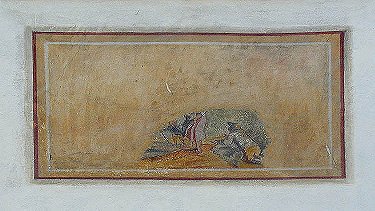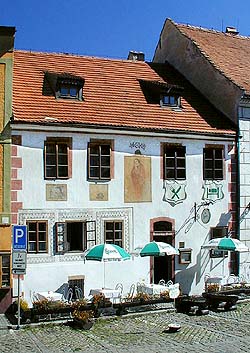Široká No. 49
Description of the Building:
A one-storey mainly late Gothic house with exceptionally
well-preserved Rennaissance reconstructions and with a richly
decorated facade.
Architectural and Historical Development:
The house ranks among the oldest inhabitable buildings on this
street. The core of the house is late Gothic and underwent some
important reconstructions in the Rennaissance period and in the
third quarter of the 17th century. During one of those
reconstructions the size of the building was changed - some remains
of two small walled-up windows give evidence that the building used
to be higher than corresponds with the present condition. Setting
of Rococo pictures (with natural figural scenes) just below today´s
larger windows on the first floor provide evidence that the windows
were broken through at the same time that the pictures were
painted. The layout of the house, created by Rennaissance
reconstructions, was slightly modified by Classical renovations.
The originally higher hall on the ground floor was changed by
setting a new staircase. The vaulting of the front cellar and a
renovation of the front wall were probably done at the same time.
Baroque reconstructions probably concerned only the front. The
layout of the division walls on the first floor is up-to-date.
Significant Architectural Features:
The building is of great art value as a whole as well as for its
exceptionally well-preserved Rennaissance sections on the ground
floor. The house has a richly decorated facade with clear traces of
various different reconstructions. Three left ground floor windows
are stressed by a sgraffito stripe of a sea wave with red sketches.
A part of the mural with Madonna, dated from 1664, probably relates
to the time of reconstruction when the windows had yellow frames
and the edges of the front were skirted with yellow boss. In the
interior the ground floor staircase hall, the narrow space along
the right hand side and originally a homogenous room with a
Rennaissance girder with a carved plait, later divided into two
parts, are worth mentioning.

|

|
History of the House Residents:
The house belongs among the oldest inhabitable buildings on the
eastern side of present Široká street. Mr and Mrs Khelb can be
found in the town register as first known owners of the house. A
quick changing of owners who ran different trades was typical for
this house. Among the first owners who changed in the house during
the 16th century, according to archival resources, were for example
a shoemaker Kunc, a tailor Wolf or Welfl, a tailor Mikuláš and a
butcher Tomandl Hörizer. In the years 1601 - 1623 the house
belonged to a shoemaker Štefan Prübis and from 1636 until at least
1654 it belonged to a maltster Pavel Straninger. In 1663 a royal
silver smelter Kryštof Pummeritz or Pumrich moved there. From 1721
to 1744 a tailor Jan Wolfgang Pichler lived in the house. In the
second half of the 18th century and in the 19th century the owners
changed fairly quickly and we do not know any further details about
them apart from their names.
Stories And Other Interesting
Information:
It is said that strange sounds are sometimes heard from the loft as
if somebody were moving furniture. It is connected with an
unfortunate accident which took place in the house. Once, the
landlord decided to rent out a chamber in the attic. He made an
agreement with a tenant, and the rent was even paid in advance. The
tenant, considered to be an odd man, liked spending his free time
in a pub playing cards. He quickly spent all his money and ran into
financial difficulties, and soon didn't have enough money for the
upcoming rent. After several appeals the landlord decided to evict
the tenant. But the tenant had had a copy of the key made, and
decided that he wanted to get into his former flat. He succeeded,
but then realized that the chamber was empty and the furniture had
been moved to the loft. He got there as well. But as he was trying
to prepare his bed for sleeping, he fell down drunk, broke his
head, and died. Since then sounds of moving furniture have been
heard. People who have lived in the house have even said that they
heard the fall of the unlucky man.
Present Use:
Hotel Straninger and its restaurant.



